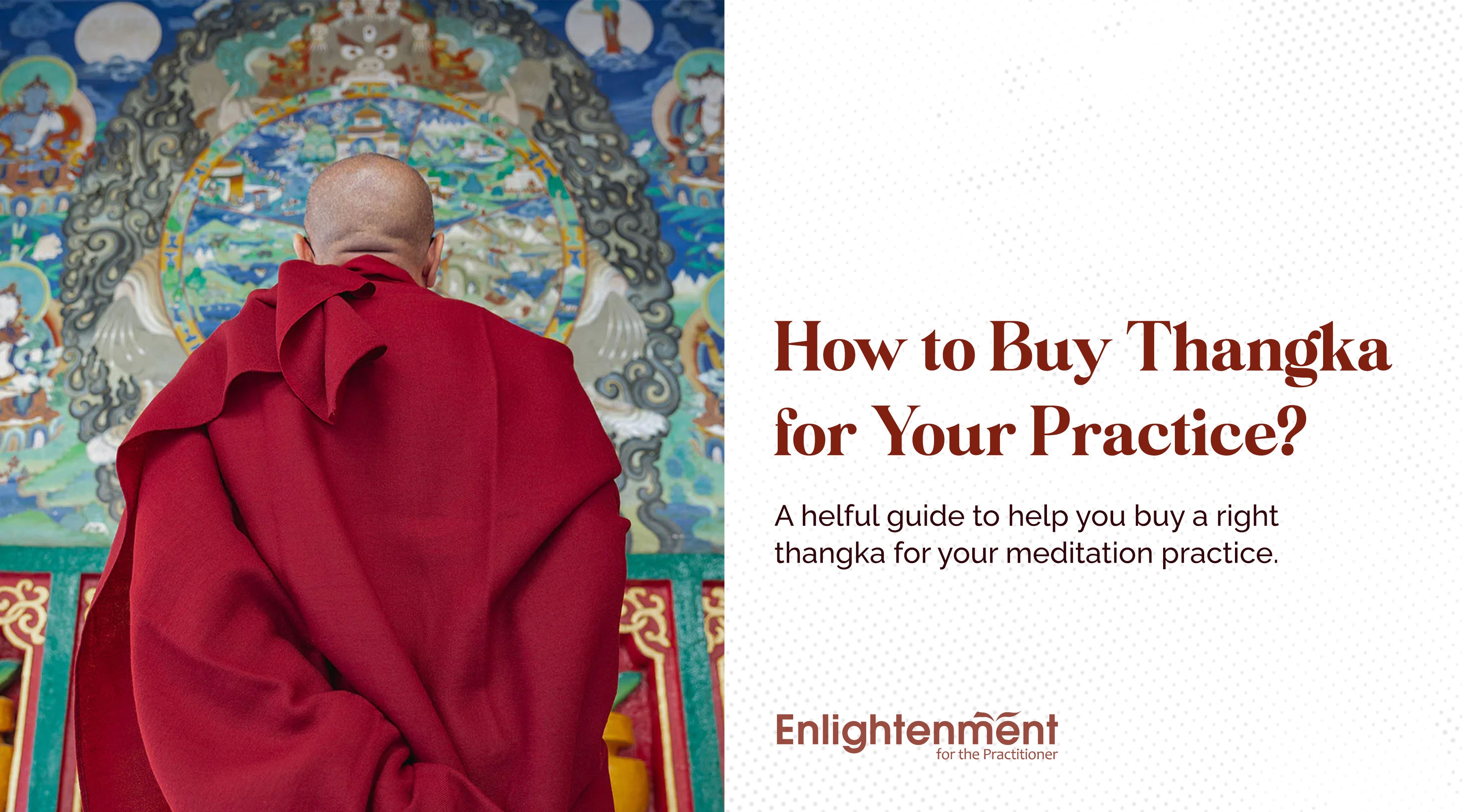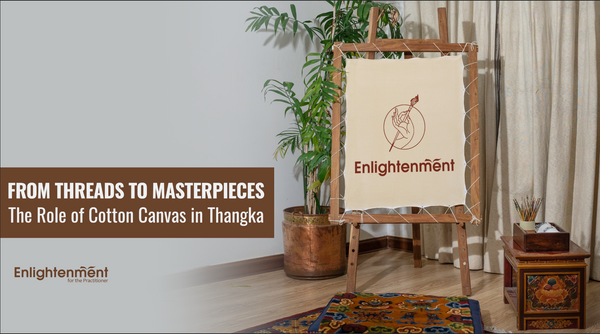Thangka, A Brief Introduction:
In Buddhist culture, Thangka is highly regarded and has a significant meaning. Traditionally it is used in teaching the practitioners about Buddha's Life, history, traditions, and other bodhisattvas. There are Thangkas having representation of deities in different forms, with distinct purposes, holding various objects, and symbolizing numerous things that are painted with the pure motivation to help you in your meditation practice.
Learn more about the Thangka, its purpose and the types of thangka.

Spiritual & Cultural Importance Of Thangka
Thangka can be used for different purposes. Not only by core practitioners but others as well, for meditation, prayer, spiritual practice, or positive vibration. Because the Thangka represents Buddha's bodily manifestations and unique attributes, it quickly converts into a meditational resource for individuals who wish to reflect on Buddha's life and existence.
Even a glance of the Thangka Art can instantly reflect its sacredness. The Thangka will be a great aid if you are into rituals and prayers. Concerning the corresponding deity on the Thangka, you can pray and performs rituals and read-aloud mantras. One can use it for cultural adaptation as well.
Thangka painting is considered a sacred object. The inclusion of any painting will spread positivity, spread Buddhism teachings, bring peace, harmony, and unity, and eliminate the evil aura around you. You can hang it in your living room, study room, or right at the entrance.
You can gift your close ones for their well-being, positiveness, and sound mind on the auspicious occasion. The intricate design filled with magnificent color is eye-catching for everyone and simply worth investing in.
Considerstions For Buying Thangka
| Consideration | Importance |
| Hand-painted | Ensures the uniqueness and authenticity of the piece |
| Natural Mineral Colors | Guarantees longevity and vibrancy of the artwork |
| Traditional Artistic Standards | Maintains the spiritual integrity and accuracy of the depicted symbols and deities |
| Mineral Pigments | To create vibrant, lasting colors |
| Gold | To embellish and highlight details |
| Cotton or Silk Canvas | To serve as the base for painting |
Evaluating the Quality of Thangka
-
Detail and Precision
High-quality Thangka is characterized by extreme detail and precision in depicting deities and symbols. Every element should be carefully and accurately rendered to convey the intended spiritual meanings. -
Color Vibrancy and Consistency
The colors in a Thangka should be vibrant and consistent, with no signs of fading or discoloration, indicating the use of high-quality pigments and proper application techniques. -
Overall Harmony and Balance
The composition of a Thangka should exhibit harmony and balance, reflecting the Buddhist principles of symmetry and proportionality, guiding the viewer's eye and facilitating meditation. -
Iconography and Symbolism
Understanding the intricate symbols, emblems, and iconography in Thangka is essential. Each symbol and deity depicted has specific spiritual significance and should align with your meditation guidelines and spiritual practices.
Taking Care of Your Thangka
Once you buy the thangka, there are several things that you need to take care of. A thangka painting is made up of elements that are sensitive to many factors such as light, water, fire, moisture, molds and other atmospheric conditions.
These paintings are done in handmade stretched cotton canvas with naturally available pigments and soluble. From natural stone colors, genuine 24K gold to the glue produced from animal skin, a traditional thangka is made out of natural elements.
As much as they are beautiful, they are vulnerable and may result in damage if not taken proper care of. The rolling and unrolling of the thangka is crucial as well. And a decent and right procedure must be followed while doing so.
Below here, we discuss some of the basic tips we can do to prevent our thangka from the damage:
1. Hanging a thangka in a traditional silk brocade
One Traditional way to protect the thangka from cracking is to hand them in silk brocade. This traditional wooden frame comes with a thin silk veil, which can be used to cover, while the thangka in not in use.

Click here to view our Hand Woven Brocade Collection
2. Regular Inspection of the Thangka
Once the thangka set up in an altar, we must not forget to inspect the thangka, on a regular basis. The painting must be protected from the direct sunlight and the humidity. Any kind of moisture can help the molds to grow on them. Hence, we must be careful of the leaked or damp walls and the temperature of the room.
Similary, the pigments in the thangka are prone to dust and pollution. Dust can cause bruises and scratches to the painting surface.
Where to Buy Authentic Thangka
Enlightenment Thangka specializes in premium quality Himalayan Thangka made in Nepal, available through our Shopify and Etsy stores. We offer a variety of Thangka, Thangka prints, singing bowls, and different styled Thangka art with varying materials of painting, aiming to evoke feelings of tranquility and enlightenment.
Our Venerable Master Jamyang Phunstok, a Kharma Gadri specialist in Tibetan thangka painting, has been a blessing. His ancestors include Thanglha Tsewang of Palpung Monastery in Kham, Eastern Tibet, who was a notable Karma Gadri artist. His wisdom and direction guided our team in crafting significant traditional Thangka for Vajrayana practitioners. It takes decades of experience to master the craft.
We do not compromise on quality as we highly believe there is a sacred value in our craftsmanship. Enlightenment is committed to creating Vajrayana art forms beneficial to your practice. We devote ourselves to creating enlightened pictures of Vajrayana deities for the practitioner.
Detailed Insight into Thangka Art Styles at Enlightenment Thangka
| Thangka Art Style | Nakthang Style | Karma Gadri Style | Menri Style | Paubha Painting Style |
| Characteristics | Precise and detailed brushwork. | Bold, colorful, and vigorous | Balance between detail and simplicity | feature intricate details, bright colors, and a distinctive use of gold leaf. |
| Use of fine lines and delicate shading. | Thick outlines and vibrant colors | Subtle use of color and intricate lines | Use of color and intricate lines, sometime geometric patterns | |
| Subjects | Primarily religious and spiritual themes.. | Similar focus on religious subjects. | Emphasis on Buddhist deities and symbols. | Common subjects include Hindu and Buddhist deities, mandalas, and religious scenes. |
| Symbolism | Depicts Tibetan Buddhist deities, mandalas, and religious narratives. | Symbolism revolves around Tibetan Buddhism, often with a narrative context. | Conveys Buddhist teachings, often in a more understated manner. | Deities represent spiritual beings and convey religious or philosophical ideas. |
|
Represents the divine in its most elaborate form, reflecting profound spiritual essence. |
Symbolizes the boundless and vibrant nature of the divine, combining artistic brilliance with spiritual depth. | It represents the divine with balance and harmony, reflecting the interconnectedness of all beings. | Traditional art form that reflects Nepal's rich cultural heritage and religious beliefs. | |
| Color Palate | Limited palette with muted earthy tones. | Vibrant and bold colors, contrasting combinations. | Softer, harmonious color schemes. | Vibrant colors like red, blue, green, and gold are used to convey emotion and energy. |
| Composition | Typically balanced and centered compositions. | Typically balanced and centered compositions. | Typically balanced and centered compositions. | Typically, the main subject is placed at the center and surrounded by intricate patterns. |
Colors Used in Thangka Paintings
At Enlightenment Thangka, various color sources are used to bring the Thangka paintings to life, each adding its unique essence to the artwork.
| Color Source | Description |
| Poster Colors | These are water-based, opaque colors that provide a smooth and uniform finish to the artwork. |
| Natural Mineral Colors | Derived from various minerals, these colors ensure vibrancy and longevity of each piece, reflecting purity and authenticity. |
| Acrylic Colors | These are modern, synthetic colors that offer brilliance and durability to the paintings |
| Real Gold and Silver | These precious metals are used to add a luxurious and divine touch to the paintings, symbolizing purity and enlightenment. |
Our Offerings
-
Original Artworks
Our original artworks are unique, hand-painted Thangkas depicting various Vajrayana deities, crafted with precision and spiritual dedication. These pieces serve as visual and symbolic representations of spiritual deities, aiding practitioners on their path to enlightenment. -
Artwork Prints
We offer high-quality prints of our original Thangkas, allowing more enthusiasts to experience the spiritual richness of Thangka art. These prints maintain the vibrancy and detail of the original pieces, serving as affordable alternatives for wider audiences. -
Brocade, Statues, and Ritual Items
Our collection extends to exquisite traditional Brocade fabric, statues, and sacred ritual items, each enhancing spiritual practices and adding to the spiritual ambiance of your space. -
Singing Bowls and Home Decor
We provide authentic Tibetan singing bowls known for their healing and meditative properties, along with spiritually resonant home decor items designed to elevate the spiritual ambiance of your space.
Why Choose Us?
Choosing Enlightenment Thangka means embracing authenticity, quality, and spiritual resonance. We are committed to preserving and promoting classical Tibetan Thangka painting while fostering artistic creativity to enrich the tradition.
- Authenticity and Quality: Our Thangkas are crafted with meticulous attention to detail, adhering to traditional artistic standards, ensuring authenticity and quality.
- Spiritual Resonance: Each piece is infused with spiritual significance, serving as a companion in your spiritual journey, aiding in meditation and contemplation.
- Diverse Collection: Our extensive collection offers a variety of Thangkas, prints, and other items, catering to different preferences and needs.
- Customer-Centric Approach: We treat our buyers as family, providing knowledgeable and friendly service and never forcing a purchase.
So, What are the Price Range of the Thangka?
Different thangka paintings in sizes and depictions of deities and their types in various scales are available. The cost will vary from one to another, depending upon the size of the thangka, the complexity of the work and the quality of the material used. However, we try to maintain the top-notch quality on every piece of art.
How to custom order a commissioned thangka?
If you are looking for a specific thangka, custom made for you, we are more than happy to accept your commissioned order. Depending upon the complexity of the deity, it will take 2-5 months for us to complete.
We have painted various thangka in the past years for many practitioners, depending upon their prescription and Sadhana Texts. You can also view some of our commissioned thangka by clicking here.


